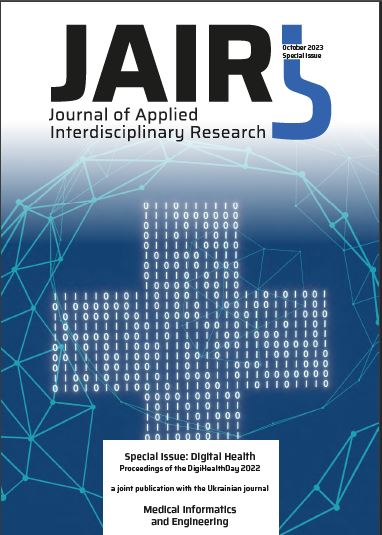Secondary Nomination and Co-Referencing of Medical Terms in the Strategy of Harmonizing Indicators of Knowledge Assimilation in the Doctor's Portfolio
Main Article Content
Keywords
Doctor's portfolio, continuous professional development of doctors, intelligent algorithms of information analysis, co-referencing of medical information, secondary nomination of medical terms, cognitive structures
Abstract
Some issues of the formation of the portfolio of doctors during continuous professional development are considered. Particular attention is paid to the peculiarities of the evaluation of the analyzed information, in particular, the problems of secondary nomination and co-referentiality of medical terms. The purpose of the study was to substantiate the prerequisites for creating a new type of portfolio by using methods of intellectual analysis of multidimensional information, as well as the formation of models and cognitive structures, which should become a central event in person-oriented active learning. It is shown that in order to ensure an adequate mechanism for evaluating multidimensional information in the doctors' portfolio, it is advisable to use ensembles of algorithms for intelligent analysis of big data. Conclusions: 1. The portfolio of doctors and pharmacists is of exceptional importance for the functioning of the system of continuous professional development of the relevant specialists. It helps organize lifelong learning and allows you to keep all evidence of learning and professional activity. 2. Taking into account the importance of the portfolio, it should be capable of standardized and formally calculated evaluation. 3. The entry of information into the portfolio is preceded by the determination of the semantic equivalence of the available information regarding the acquisition and assimilation of knowledge. 4. It is proposed to use ensembles of approaches to the analysis and arrangement of information in the portfolio - a combination of several algorithms that function simultaneously and provide an opportunity to correct possible errors. 5. The proposed decision-making algorithm during the preliminary analysis of information for the portfolio.
References
training in the Western Cape, South Africa. BMC Med Educ. 2019;19(1). doi:10.1186/s12909-019-1692-x
2. Sukhanova O. Logics and basic principles for evaluation of quality of doctors’ continuing professional development using the electronic portfolio. Regional Innovations Medical Science. 2021;2:11-14.
3. Tochel C, Haig A, Hesketh A, et al. The effectiveness of portfolios for post-graduate Assessment and Education: BEME Guide No
12. Medical Teacher. 2009;31(4):299-318. doi:10.1080/01421590902883056.
4. Van Tartwijk J, Driessen EW. Portfolios for assessment and learning: AMEE Guide No. 45. Medical Teacher. 2009;31(9):790-801.
doi:10.1080/01421590903139201.
5. Tsisar N. System-forming potential of secondary medical names. Bulletin of the Lviv Polytechnic National University (Series "Problems of Ukrainian Terminology).2010;675:54–56
6. Mintser OP, Babintseva LYu, Sukhanova OO. The logic of concordance of indicators of knowledge assimilation in the doctor's
portfolio. Medical Informatics and Engineering. 2022;1-2(57-58):56-63. doi:10.11603/mie.1996-1960.2022.1-2.13112
7. Mintser OP, Popova MA, Ladychuk OK, Koshova SP. Taxonomy usage for postgraduate content improvement. Medical Informatics and
Engineering. 2020:3(51):33-40. doi: 10.11603/ mie.1996-1960.2020.3.11604
8. Kotova EE. Intellectual data analysis in the educational process. 2017 XX IEEE International Conference on Soft Computing and Measurements (SCM). 2017. doi:10.1109/SCM.2017.7970714
9. Sidey-Gibbons JA, Sidey-Gibbons CJ. Machine learning in medicine: a practical introduction. BMC Med Res Methodol. 2019;19(1). DOI:
10.1186/s12874-019-0681-4.
10. England R. Mastering ITIL. (Translation from English). Livebook. 2011.
11. Schawel C, Billing F. Top 100 Management Tools. 2011. doi:10.1007/978-3-8349-6605-6
12. Ferracane E, Marshall L, Wallace BC, Erk K. Leveraging coreference to identify arms in medical abstracts: An experimental study.
Seventh International Workshop on Health Text Mining and Information Analysis (LOUHI).
2016. 86-95. Austin
13. Soon WM, Lim DC, Ng HT. A Machine Learning Approach to Coreference Resolution of Noun Phrases. Computational Linguistics.
2001;4(27):521-544.
14. Denis P, Baldridge J. Specialized Models and Ranking for Coreference Resolution. In Proceedings of the 2008 Conference on Empirical. Methods in Natural Language Processing. Honolulu. Hawaii. 2008. 660-669. doi:10.3115/1613715.1613797
15. Thorsten J, Chun-Nam JY. Learning structural SVMs with latent variables. In Proceedings of the 26th Annual International Conference on Machine Learning, ACM. 2009. New York


